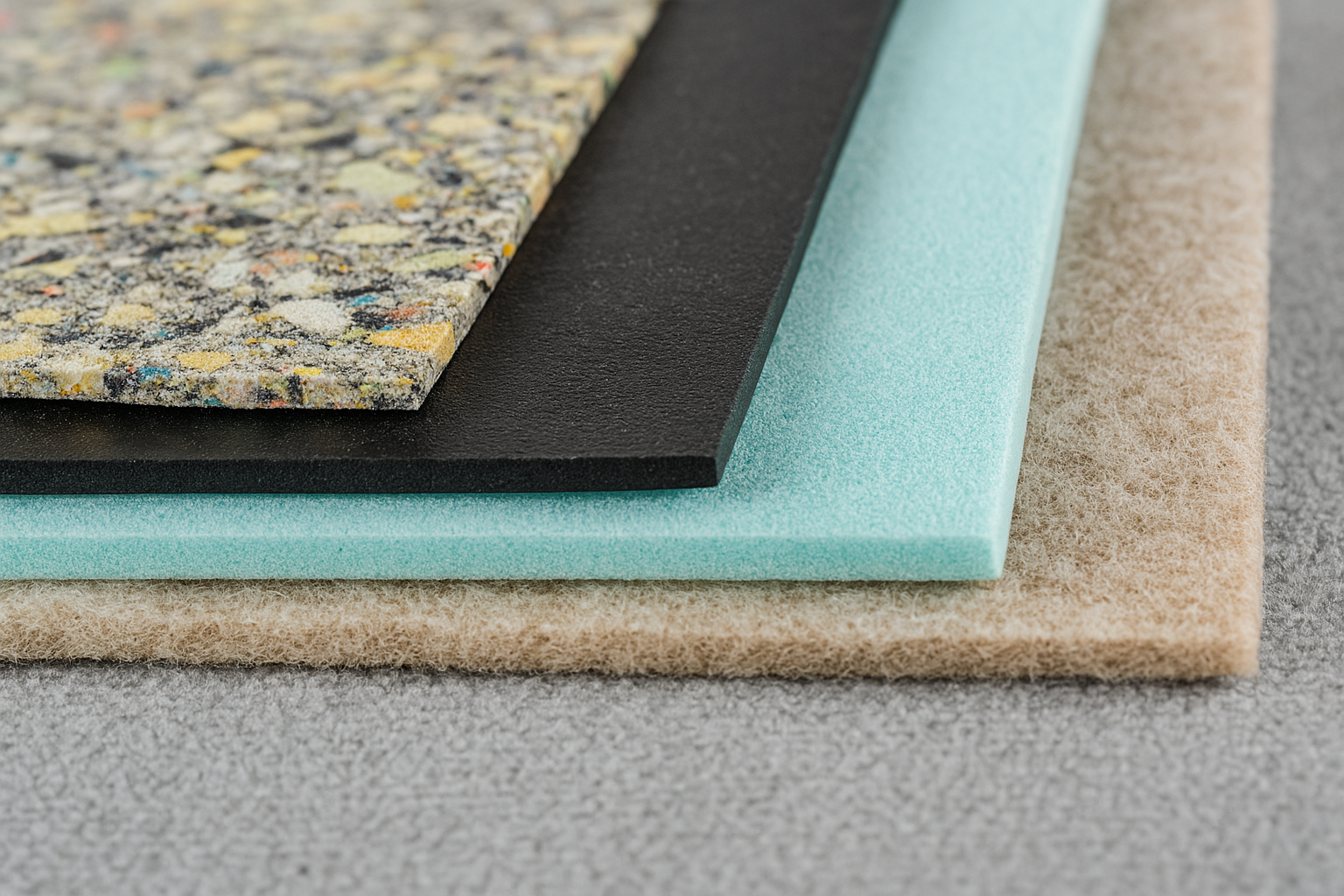Carpet padding is the hidden layer that makes your carpet feel soft, last longer, and stay quiet underfoot. Yet, many homeowners overlook how much the type of carpet pad affects comfort, durability, and insulation. Below, we break down the most common carpet padding types—what they’re made of, where they work best, and how to pick the right one for your space.
Why Carpet Padding Matters
Padding acts as the shock absorber between your carpet and subfloor. It prevents premature wear, improves sound insulation, and adds cushioning for comfort. More importantly, it supports your carpet’s backing to prevent stretching and fraying. Whether you’re installing in a high-traffic living room, basement, or bedroom, choosing the correct pad makes a big difference in both feel and longevity.
1. Rebond Carpet Padding
Rebond padding is the most common type for residential use. Made from recycled foam pieces, it’s affordable, eco-friendly, and available in multiple densities and thicknesses.
- Best for: Living rooms, bedrooms, hallways
- Pros: Budget-friendly, comfortable, widely available
- Cons: Not ideal for moisture-prone areas
If you want a balance of comfort and price, rebond padding is a great all-purpose choice. For higher performance, look for rebond with a density rating between 6–8 lbs.
2. Memory Foam Carpet Padding
Memory foam padding provides a luxurious feel underfoot. It’s often used in bedrooms and low-traffic areas where comfort is the top priority. The viscoelastic foam conforms to pressure and rebounds slowly, reducing foot fatigue.
- Best for: Bedrooms, family rooms
- Pros: Superior comfort, high insulation value
- Cons: Can be too soft for heavy furniture or rolling traffic
Over time, soft memory foam pads may cause carpets to loosen in high-traffic areas, so they’re best paired with plush pile carpets rather than low loops.
3. Rubber Carpet Padding
Rubber padding is dense, supportive, and long-lasting. It resists mildew and stands up well to heavy furniture, making it ideal for stairs and high-traffic zones. Premium versions are used in commercial settings but work equally well in busy homes.
- Best for: Stairs, hallways, offices
- Pros: Excellent support, long lifespan, moisture-resistant
- Cons: More expensive, heavier to install
4. Felt Carpet Padding
Felt padding—made from recycled fibers or wool blends—is durable and often chosen for Berber and low-pile carpets. Its firm density keeps carpets stable and minimizes stretch. Wool-based felt also adds mild soundproofing and insulation value.
- Best for: Berber carpets, stairs, and tight-weave installations
- Pros: Eco-friendly, firm, durable
- Cons: Less cushion than foam padding
5. Waterproof Carpet Padding
In basements, laundry rooms, or moisture-prone spaces, waterproof padding prevents water from soaking through to the subfloor. These pads typically have a moisture barrier film on top and are often paired with basement carpet padding and vapor barriers for full protection.
- Best for: Basements, laundry rooms, pet areas
- Pros: Blocks moisture, extends carpet life
- Cons: Slightly firmer feel underfoot
6. Specialty Carpet Pads (Soundproof, Odor-Resistant & Hypoallergenic)
Modern padding options go beyond comfort. Specialty pads are designed for unique homeowner needs—like soundproof carpet padding to reduce noise, odor-resistant padding for pet-friendly homes, or hypoallergenic padding that minimizes dust and allergens.
- Soundproof padding: Ideal for multi-level homes and apartments
- Odor-resistant padding: Contains antimicrobial and odor-blocking additives
- Hypoallergenic padding: Designed for families with asthma or allergies
How to Choose the Right Carpet Pad
- Check carpet manufacturer guidelines: Some warranties require specific padding densities.
- Match pad density to carpet type: Plush carpets need softer pads; low-pile or Berber carpets require firm pads.
- Consider your subfloor: Concrete basements need moisture protection; wood subfloors may need sound insulation.
- Balance comfort and durability: Higher density pads last longer and provide better support over time.
FAQs
What carpet pad thickness is best?
Most residential carpets perform best with padding between 7/16-inch and 3/8-inch thick. Thicker isn’t always better—too soft a pad can cause carpet stretching or wrinkling.
Can I reuse old carpet padding?
It’s not recommended. Old padding often contains dirt, dust mites, and has already lost resilience. Always install new padding with new carpet for proper performance and warranty coverage.
What’s the most durable type of carpet pad?
Rubber and high-density felt pads are the most durable. They resist crushing and maintain their shape for many years, even under heavy furniture or high traffic.
Related: Best Basement Carpet Padding • Eco-Friendly Carpet Padding Options • Soundproof Carpet Padding
